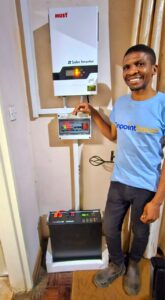Beyond the Sun: Exploring Common Solar Systems in Zimbabwe
Are you looking for a solar system in Harare or Zimbabwe? Call 0773813171 for a reliable and affordable in Harare and Zimbabwe
 Zimbabwe, a country blessed with abundant sunshine, is increasingly embracing the power of the sun. The shift towards solar energy is not only driven by environmental concerns but also by a desire to alleviate energy shortages and reduce dependence on fossil fuels.
Zimbabwe, a country blessed with abundant sunshine, is increasingly embracing the power of the sun. The shift towards solar energy is not only driven by environmental concerns but also by a desire to alleviate energy shortages and reduce dependence on fossil fuels.
This has led to a rise in the popularity of various solar systems, each tailored to meet specific needs and budgets.
In this blog post, we delve into the common solar systems found in Zimbabwe, shedding light on their workings, benefits, and considerations for potential users.
1. Standalone Solar Systems:
These systems are perfect for remote areas or off-grid applications where access to the national grid is limited or nonexistent. They typically consist of:
Solar panels: These panels absorb sunlight and convert it into direct current (DC) electricity.
Charge controller: Regulates the flow of electricity from the solar panels to the battery bank, preventing overcharging and protecting the battery’s lifespan.
Battery bank: Stores the DC electricity generated by the solar panels for later use.
Inverter: Converts DC electricity from the battery bank to alternating current (AC) electricity compatible with household appliances.
Benefits of a standalone solar system:
Energy independence: Standalone systems provide complete autonomy from the grid, eliminating reliance on unstable power supply.
Cost-effective in the long run: While the initial investment can be higher, the absence of electricity bills over time makes it a financially viable option.
Environmental friendliness: Reduces carbon emissions and reliance on fossil fuels, promoting a sustainable energy future.
Considerations:
System sizing: Determining the right size for the system is crucial. This requires considering energy needs, panel efficiency, battery capacity, and daily sunlight hours.
Maintenance: Regular maintenance is essential for optimal performance and lifespan, including cleaning panels, checking battery water levels, and inspecting wiring.
Weather conditions: Performance can be affected by cloud cover and prolonged rainy seasons, requiring a larger system or backup power sources.
2. Grid-Tied Solar Systems:
These systems are connected to the national grid and are designed to supplement existing electricity supply. They operate by:
Solar panels: Generate DC electricity directly from sunlight.
Inverter: Converts DC electricity to AC electricity compatible with the grid.
Metering system: Tracks the amount of electricity produced and consumed, enabling net metering.
Benefits of a grid tied solar system
Reduced electricity bills: Electricity generated by the solar system offsets consumption from the grid, leading to lower bills.
Government incentives: Some governments offer incentives like feed-in tariffs for excess electricity fed back into the grid.
Improved grid reliability: Reduces strain on the grid during peak hours, contributing to stability.
Considerations:
Grid connection: Requires approval and connection to the national grid, which can involve paperwork and technical requirements.
Limited functionality during power outages: When the grid is down, the system shuts down for safety reasons.
Energy storage limitations: Typically lacks battery storage, relying on the grid for uninterrupted power supply.
3. Hybrid Solar Systems:
These systems combine the features of both standalone and grid-tied systems, offering a balanced approach:
Solar panels: Generate DC electricity from sunlight.
Charge controller: Regulates the flow of electricity from the panels to the battery bank.
Battery bank: Stores DC electricity for use during grid outages or high demand.
Inverter: Converts DC electricity to AC electricity compatible with household appliances.
Grid connection: Allows the system to draw power from the grid when solar production is insufficient or to sell excess electricity.
Benefits:
Enhanced energy independence: Provides reliable power even during grid outages or peak demand periods.
Flexibility: Can switch between grid-tied and standalone operation depending on the situation.
Improved cost-effectiveness: Balances initial investment with long-term savings on electricity bills.
Considerations:
Complex installation: Hybrid systems require a more intricate setup compared to standalone or grid-tied systems.
Higher initial cost: The combination of components leads to a greater initial investment.
Maintenance: Requires diligent maintenance for both the solar and battery components.
Choosing the Right Solar System for Zimbabwe:
The best solar system for you depends on several factors, including:
Energy needs: Determine your daily electricity consumption and peak demand periods.
Budget: Consider the upfront costs, maintenance expenses, and potential savings over time.
Location and grid access: Assess the availability of sunlight, grid reliability, and grid connection requirements.
Government incentives: Check for any local incentives or subsidies available for solar energy.
Conclusion:
With its abundant sunshine, Zimbabwe presents a compelling opportunity to harness solar energy for a brighter future. Understanding the various solar system options available, their benefits, and considerations can empower individuals and communities to make informed decisions about their energy needs and contribute to a sustainable energy landscape. Whether choosing standalone, grid-tied, or hybrid systems, exploring the potential of solar energy in Zimbabwe is a step towards a cleaner, brighter, and more resilient future.
